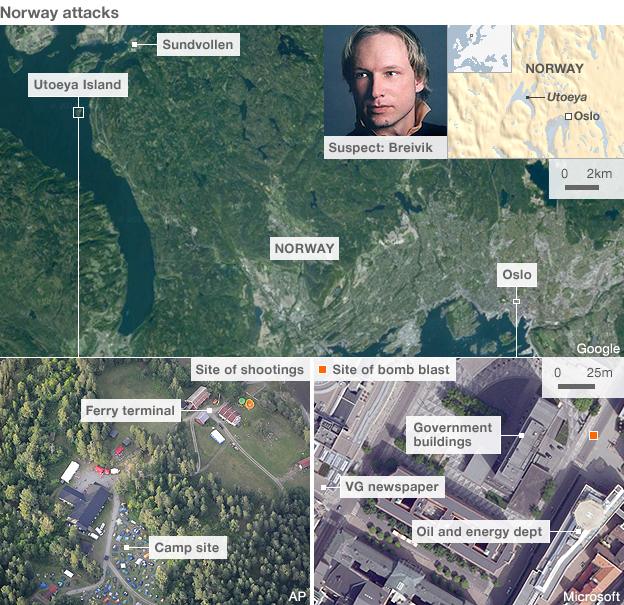Norway police say 85 killed in island youth camp attack
- Published
Adrian Pracon says he played dead to try and avoid the gunman on Utoeya
At least 85 people died when a gunman opened fire at an island youth camp in Norway, hours after a bombing in the capital Oslo killed seven, police say.
Police have charged a 32-year-old Norwegian man over both attacks.
The man dressed as a police officer was arrested on tiny Utoeya island after an hour-long shooting spree.
Prime Minister Jens Stoltenberg said many people were still looking for their children and had not so far been able to locate them.
He was speaking after meeting victims and relatives with Norway's King Harald, Queen Sonja and Crown Prince Haakon in the town of Sundvollen near the island.
Mr Stoltenberg said he was "deeply touched" by the meetings. "We will do whatever we can to give them as much support as possible," he said.
Earlier he said that he was due to have been on Utoeya - "a youth paradise turned into a hell" - a few hours after the attack took place.
The suspect is reported by local media to have had links with right-wing extremists. He has been named as Anders Behring Breivik. Police searched his Oslo apartment overnight and are questioning him.
The BBC's Richard Galpin, near the island which is currently cordoned off by police, says that Norway has had problems with neo-Nazi groups in the past but the assumption was that such groups had been largely eliminated and did not pose a significant threat.
Police say they are investigating whether the attacks were the work of one man or whether others helped.
"At Utoeya, the water is still being searched for more victims," deputy police chief Roger Andresen told reporters.
"We have no more information than... what has been found on [his] own websites, which is that it goes towards the right and that it is, so to speak, Christian fundamentalist."
Local media report that police are investigating claims by witnesses that a second person was involved, apparently not disguised in a police uniform.
A farm supply firm has confirmed selling six tonnes of fertiliser to Mr Breivik who is reported to have run a farming company. Speculation has been rife that fertiliser could have been used in the Oslo bomb.
'Posed as policeman'
The number killed in the island shooting spree, which is among the world's most deadly, had been put at 10 on Friday - but soared overnight. Hundreds of young people had been attending the summer camp organised by the governing Labour Party on Utoeya island.
Eyewitnesses described how a tall, blond man dressed as a policeman opened fire indiscriminately, prompting camp attendees to jump into the water to try to escape the hail of bullets.
Some of the teenagers were shot at as they tried to swim to safety.
Armed police were deployed to the island but details of the operation to capture the suspect remain unclear. After his arrest he was charged with committing acts of terrorism.
Police say they discovered many more victims after searching the area around the island. They have warned the death toll may rise further as rescue teams continue to scour the waters around the island.
The gunman is reported to have been armed with a handgun, an automatic weapon and a shotgun.
"He travelled on the ferry boat from the mainland over to that little inland island posing as a police officer, saying he was there to do research in connection with the bomb blasts," NRK journalist Ole Torp told the BBC.
"He asked people to gather round and then he started shooting, so these young people fled into the bushes and woods and some even swam off the island to get to safety."
One 15-year-old eyewitness described how she saw what she thought was a police officer open fire.
"He first shot people on the island. Afterward he started shooting people in the water," youth camp delegate Elise told Associated Press.
Witness Daniel Cherubini says it was "absolute chaos" in Oslo following Friday's bombing
'Despicable violence'
The attacks sparked strong international condemnation, with US President Barack Obama expressing his condolences and offering support.
Britain's Queen Elizabeth II spoke of her shock and sadness in a letter to King Harald.
In Oslo, government officials urged people to stay at home and avoid central areas of the city.
Shards of twisted metal, rubble and glass littered the streets of central Oslo left devastated by Friday's enormous explosion.
Windows in the buildings of the government quarter were shattered and witnesses described how smoke filled the atmosphere around the blast site.
The BBC's John Sopel in Oslo says there is a heavy military presence, with checkpoints around the quarter.
Mr Stoltenberg said civil servants were among the dead in Oslo and he knew some of those killed.
There are also concerns that more victims may still be inside buildings hit by the initial massive explosion.
